 W
WAlhazen's problem, also known as Alhazen's billiard problem, is a mathematical problem in geometrical optics first formulated by Ptolemy in 150 AD. It is named for the 11th-century Arab mathematician Alhazen who presented a geometric solution in his Book of Optics. The algebraic solution involves quartic equations and was found in 1965 by Jack M. Elkin.
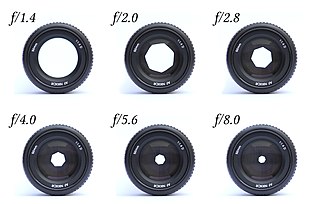 W
WIn optics, an aperture is a hole or an opening through which light travels. More specifically, the aperture and focal length of an optical system determine the cone angle of a bundle of rays that come to a focus in the image plane.
 W
WBrewster's angle is an angle of incidence at which light with a particular polarization is perfectly transmitted through a transparent dielectric surface, with no reflection. When unpolarized light is incident at this angle, the light that is reflected from the surface is therefore perfectly polarized. This special angle of incidence is named after the Scottish physicist Sir David Brewster (1781–1868).
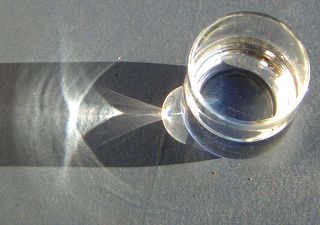 W
WIn optics, a caustic or caustic network is the envelope of light rays reflected or refracted by a curved surface or object, or the projection of that envelope of rays on another surface. The caustic is a curve or surface to which each of the light rays is tangent, defining a boundary of an envelope of rays as a curve of concentrated light. Therefore, in the photo on the side, caustics can be seen as patches of light or their bright edges. These shapes often have cusp singularities.
 W
WIn optics, chromatic aberration (CA), also called chromatic distortion and spherochromatism, is a failure of a lens to focus all colors to the same point. It is caused by dispersion: the refractive index of the lens elements varies with the wavelength of light. The refractive index of most transparent materials decreases with increasing wavelength. Since the focal length of a lens depends on the refractive index, this variation in refractive index affects focusing. Chromatic aberration manifests itself as "fringes" of color along boundaries that separate dark and bright parts of the image.
 W
WIn optics, a circle of confusion is an optical spot caused by a cone of light rays from a lens not coming to a perfect focus when imaging a point source. It is also known as disk of confusion, circle of indistinctness, blur circle, or blur spot.
 W
WThe circumzenithal arc, also called the circumzenith arc (CZA), upside-down rainbow, and the Bravais arc, is an optical phenomenon similar in appearance to a rainbow, but belonging to the family of halos arising from refraction of sunlight through ice crystals, generally in cirrus or cirrostratus clouds, rather than from raindrops. The arc is located at a considerable distance above the observed Sun and at most forms a quarter of a circle centered on the zenith. It has been called "a smile in the sky", its first impression being that of an upside-down rainbow. The CZA is one of the brightest and most colorful members of the halo family. Its colors, ranging from violet on top to red at the bottom, are purer than those of a rainbow because there is much less overlap in their formation.
 W
WIn geometry, the conic constant is a quantity describing conic sections, and is represented by the letter K. The constant is given by
 W
WIn optics, defocus is the aberration in which an image is simply out of focus. This aberration is familiar to anyone who has used a camera, videocamera, microscope, telescope, or binoculars. Optically, defocus refers to a translation of the focus along the optical axis away from the detection surface. In general, defocus reduces the sharpness and contrast of the image. What should be sharp, high-contrast edges in a scene become gradual transitions. Fine detail in the scene is blurred or even becomes invisible. Nearly all image-forming optical devices incorporate some form of focus adjustment to minimize defocus and maximize image quality.
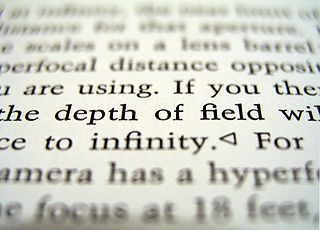 W
WFor many cameras, depth of field (DOF) is the distance between the nearest and the farthest objects that are in acceptably sharp focus in an image. The depth of field can be calculated based on focal length, distance to subject, the acceptable circle of confusion size, and aperture. A particular depth of field may be chosen for technical or artistic purposes. Limitations of depth of field can sometimes be overcome with various techniques/equipment.
 W
WIn geometric optics, distortion is a deviation from rectilinear projection; a projection in which straight lines in a scene remain straight in an image. It is a form of optical aberration.
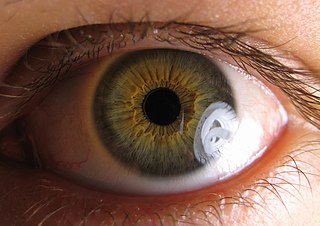 W
WIn an optical system, the entrance pupil is the optical image of the physical aperture stop, as 'seen' through the front of the lens system. The corresponding image of the aperture as seen through the back of the lens system is called the exit pupil. If there is no lens in front of the aperture, the entrance pupil's location and size are identical to those of the aperture. Optical elements in front of the aperture will produce a magnified or diminished image that is displaced from the location of the physical aperture. The entrance pupil is usually a virtual image: it lies behind the first optical surface of the system.
 W
WFermat's principle, also known as the principle of least time, is the link between ray optics and wave optics. In its original "strong" form, Fermat's principle states that the path taken by a ray between two given points is the path that can be traversed in the least time. In order to be true in all cases, this statement must be weakened by replacing the "least" time with a time that is "stationary" with respect to variations of the path — so that a deviation in the path causes, at most, a second-order change in the traversal time. To put it loosely, a ray path is surrounded by close paths that can be traversed in very close times. It can be shown that this technical definition corresponds to more intuitive notions of a ray, such as a line of sight or the path of a narrow beam.
 W
WIn geometrical optics, a focus, also called an image point, is a point where light rays originating from a point on the object converge. Although the focus is conceptually a point, physically the focus has a spatial extent, called the blur circle. This non-ideal focusing may be caused by aberrations of the imaging optics. In the absence of significant aberrations, the smallest possible blur circle is the Airy disc, which is caused by diffraction from the optical system's aperture. Aberrations tend worsen as the aperture diameter increases, while the Airy circle is smallest for large apertures.
 W
WThe Fresnel equations describe the reflection and transmission of light when incident on an interface between different optical media. They were deduced by Augustin-Jean Fresnel who was the first to understand that light is a transverse wave, even though no one realized that the "vibrations" of the wave were electric and magnetic fields. For the first time, polarization could be understood quantitatively, as Fresnel's equations correctly predicted the differing behaviour of waves of the s and p polarizations incident upon a material interface.
 W
WA light beam or beam of light is a directional projection of light energy radiating from a light source. Sunlight forms a light beam when filtered through media such as clouds, foliage, or windows. To artificially produce a light beam, a lamp and a parabolic reflector is used in many lighting devices such as spotlights, car headlights, PAR Cans, and LED housings. Light from certain types of laser has the smallest possible beam divergence.
 W
WA METATOY is a sheet, formed by a two-dimensional array of small, telescopic optical components, that switches the path of transmitted light rays. METATOY is an acronym for "metamaterial for rays", representing a number of analogies with metamaterials; METATOYs even satisfy a few definitions of metamaterials, but are certainly not metamaterials in the usual sense. When seen from a distance, the view through each individual telescopic optical component acts as one pixel of the view through the METATOY as a whole. In the simplest case, the individual optical components are all identical; the METATOY then behaves like a homogeneous, but pixellated, window that can have very unusual optical properties.
 W
WAn optical axis is a line along which there is some degree of rotational symmetry in an optical system such as a camera lens, microscope or telescopic sight.
 W
WIn geometric optics, the paraxial approximation is a small-angle approximation used in Gaussian optics and ray tracing of light through an optical system.
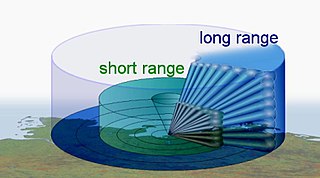 W
WIn optics, a pencil or pencil of rays is a geometric construct used to describe a beam or portion of a beam of electromagnetic radiation or charged particles, typically in the form of a narrow cone or cylinder.
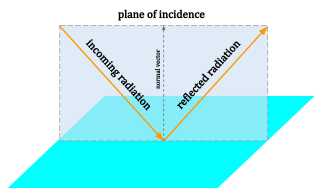 W
WIn describing reflection and refraction in optics, the plane of incidence is the plane which contains the surface normal and the propagation vector of the incoming radiation.
 W
WRadius of curvature (ROC) has specific meaning and sign convention in optical design. A spherical lens or mirror surface has a center of curvature located either along or decentered from the system local optical axis. The vertex of the lens surface is located on the local optical axis. The distance from the vertex to the center of curvature is the radius of curvature of the surface.
 W
WIn 3D computer graphics, ray tracing is a rendering technique for generating an image by tracing the path of light as pixels in an image plane and simulating the effects of its encounters with virtual objects. The technique is capable of producing a high degree of visual realism, more so than typical scanline rendering methods, but at a greater computational cost. This makes ray tracing best suited for applications where taking a relatively long time to render can be tolerated, such as in still computer-generated images, and film and television visual effects (VFX), but generally more poorly suited to real-time applications such as video games, where speed is critical in rendering each frame. In recent years, however, hardware acceleration for real-time ray tracing has become standard on new commercial graphics cards, and graphics APIs have followed suit, allowing developers to add real-time ray tracing techniques to games and other real-time rendered media with a lesser, albeit still substantial hit to frame render times.
 W
WReflection is the change in direction of a wavefront at an interface between two different media so that the wavefront returns into the medium from which it originated. Common examples include the reflection of light, sound and water waves. The law of reflection says that for specular reflection the angle at which the wave is incident on the surface equals the angle at which it is reflected. Mirrors exhibit specular reflection.
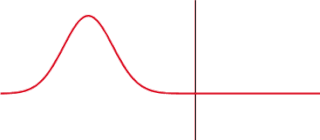 W
WIn physics and electrical engineering the reflection coefficient is a parameter that describes how much of a wave is reflected by an impedance discontinuity in the transmission medium. It is equal to the ratio of the amplitude of the reflected wave to the incident wave, with each expressed as phasors. For example, it is used in optics to calculate the amount of light that is reflected from a surface with a different index of refraction, such as a glass surface, or in an electrical transmission line to calculate how much of the electromagnetic wave is reflected by an impedance. The reflection coefficient is closely related to the transmission coefficient. The reflectance of a system is also sometimes called a "reflection coefficient".
 W
WIn physics, refraction is the change in direction of a wave passing from one medium to another or from a gradual change in the medium. Refraction of light is the most commonly observed phenomenon, but other waves such as sound waves and water waves also experience refraction. How much a wave is refracted is determined by the change in wave speed and the initial direction of wave propagation relative to the direction of change in speed.
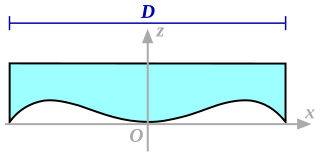 W
WA Schmidt corrector plate is an aspheric lens which corrects the spherical aberration introduced by the spherical primary mirror of the Schmidt or Schmidt-Cassegrain telescope designs. It was invented by Bernhard Schmidt in 1931, although it may have been independently invented by Finnish astronomer Yrjö Väisälä in 1924. Schmidt originally introduced it as part of a wide-field photographic catadioptric telescope, the Schmidt camera. It is now used in several other telescope designs, camera lenses and image projection systems that utilise a spherical primary mirror.
 W
WSignal reflection occurs when a signal is transmitted along a transmission medium, such as a copper cable or an optical fiber. Some of the signal power may be reflected back to its origin rather than being carried all the way along the cable to the far end. This happens because imperfections in the cable cause impedance mismatches and non-linear changes in the cable characteristics. These abrupt changes in characteristics cause some of the transmitted signal to be reflected. In radio frequency (RF) practice this is often measured in a dimensionless ratio known as voltage standing wave ratio (VSWR) with a VSWR bridge. The ratio of energy bounced back depends on the impedance mismatch. Mathematically, it is defined using the reflection coefficient.
 W
WSnell's law is a formula used to describe the relationship between the angles of incidence and refraction, when referring to light or other waves passing through a boundary between two different isotropic media, such as water, glass, or air.
 W
WSnell's window is a phenomenon by which an underwater viewer sees everything above the surface through a cone of light of width of about 96 degrees. This phenomenon is caused by refraction of light entering water, and is governed by Snell's Law. The area outside Snell's window will either be completely dark or show a reflection of underwater objects by total internal reflection.
 W
WSpecular reflection, or regular reflection, is the mirror-like reflection of waves, such as light, from a surface.
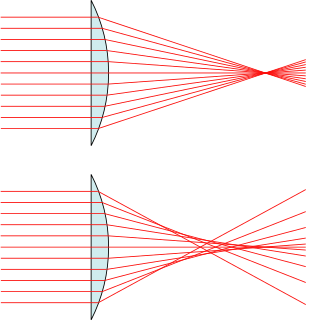 W
WSpherical aberration (SA) is a type of aberration found in optical systems that use elements with spherical surfaces. Lenses and curved mirrors are most often made with surfaces that are spherical, because this shape is easier to form than non-spherical curved surfaces. Light rays that strike a spherical surface off-centre are refracted or reflected more or less than those that strike close to the centre. This deviation reduces the quality of images produced by optical systems.
 W
WA toric lens is a lens with different optical power and focal length in two orientations perpendicular to each other. One of the lens surfaces is shaped like a "cap" from a torus, and the other one is usually spherical. Such a lens behaves like a combination of a spherical lens and a cylindrical lens. Toric lenses are used primarily in eyeglasses, contact lenses and intraocular lenses to correct astigmatism.
 W
WTotal internal reflection (TIR) is the optical phenomenon in which the surface of the water in a fish-tank when viewed from below the water level, reflects the underwater scene like a mirror, with no loss of brightness (Fig. 1). In general, TIR occurs when waves in one medium reach the boundary with another medium at a sufficiently slanting angle, provided that the second ("external") medium is transparent to the waves and allows them to travel faster than in the first ("internal") medium. TIR occurs not only with electromagnetic waves such as light and microwaves, but also with other types of waves, including sound and water waves. In the case of a narrow train of waves, such as a laser beam (Fig. 2), we tend to describe the reflection in terms of "rays" rather than waves. In a medium whose properties are independent of direction, such as air, water, or glass, each "ray" is perpendicular to the associated wavefronts.
 W
WThe transmission coefficient is used in physics and electrical engineering when wave propagation in a medium containing discontinuities is considered. A transmission coefficient describes the amplitude, intensity, or total power of a transmitted wave relative to an incident wave.
 W
WVeiling glare is an imperfection of performance in optical instruments arising from incoming light that strays from the normal image-forming paths, and reaches the focal plane. The effect superimposes a form of noise onto the normal image sensed by the detector, resulting in a final image degraded by loss of contrast and reduced definition.
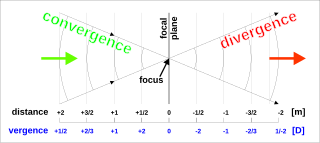 W
WVergence is the angle formed by rays of light that are not perfectly parallel to one another. Rays that move closer to the optical axis as they propagate are said to be converging, while rays that move away from the axis are diverging. These imaginary rays are always perpendicular to the wavefront of the light, thus the vergence of the light is directly related to the radii of curvature of the wavefronts. A convex lens or concave mirror will cause parallel rays to focus, converging toward a point. Beyond that focal point, the rays diverge. Conversely, a concave lens or convex mirror will cause parallel rays to diverge.